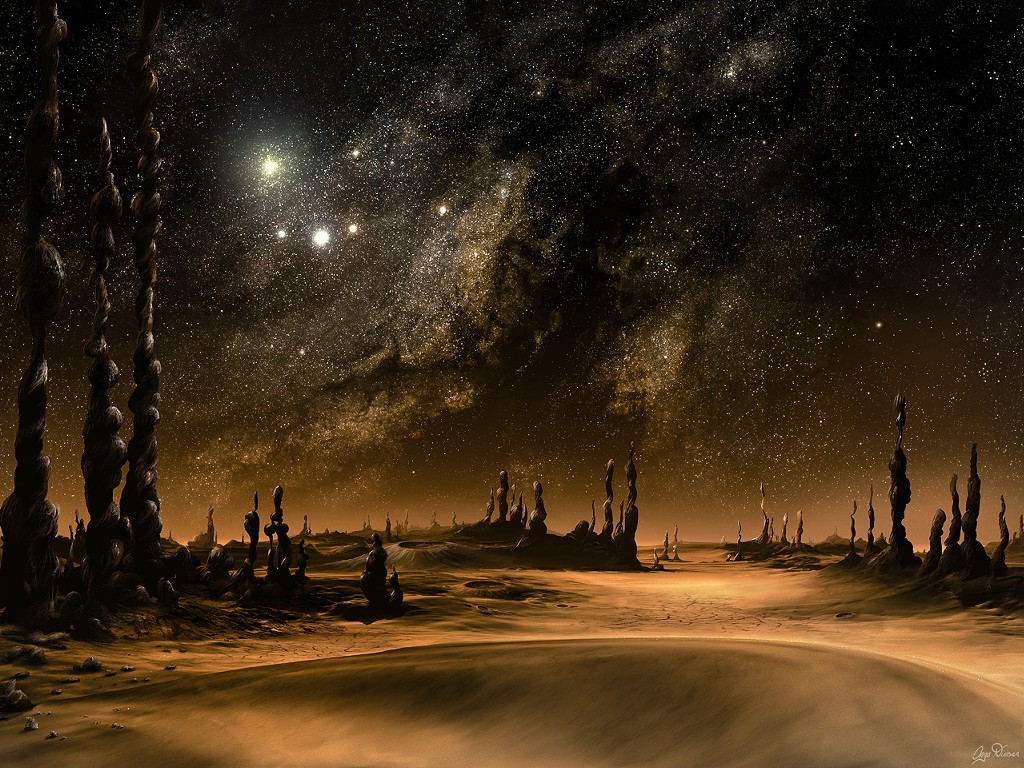
| Main | Neocene |

All pictures are taken from open sources and belong to their authors
Studies have already revealed exoplanets completely covered
with water (and most likely almost all “super-earths” are ocean planets) and
even consisting mostly of water. Articles have already covered both cases. Also
the opposite case is possible – the planet poor in water. A well-known example
is Mars, where once there were conditions for the appearance of oceans; however,
there was nothing really to fill them with.
We should start with the circumstances under which exoplanets can remain without
water. Firstly, the cause of the drought may be the formation in orbit too close
to the sun, in conditions of high temperature and significant pressure of the
solar wind, expelling light substances from the protoplanetary ring. It happened
so on Mercury. However, such example can hardly be characteristic, since a red-hot
planet will not be suitable for life in any case.
Caused by the proximity to the sun, too high a temperature on the surface can
deprive the planet of water in another scenario – the Venusian one. If water
exists only in the form of steam, a planet the size of Earth will be able to
hold it only partially – that is, to keep the heavy part of the water, oxygen
(which will combine then with carbon from the crust of the planet). Hydrogen,
which was part of the molecules destroyed by the solar wind, will evaporate.
Finally, thirdly, the lack of water can be caused by factors such as the absence
of a massive moon and insufficient own size. It actually can be observed in
the case of Mars. The low intensity of volcanism (although the size of Olympus
Mons, at first glance, indicates the opposite) and its early termination, combined
with low gravity, led to the fact that only a small amount of volatile substances
was released from the planet bowels, and most of them had been lost.
Thus, a combination of general habitability with a shortage of water can occur
on a massive planet – the size of the Earth or more – but having no external
sources fueling seismic activity. That is, it can hardly be a planet in the
red dwarf system. A dim and lightweight star keeps its planets on a short leash,
warming only the nearest ones, which lack an opportunity to acquire moons (for
this reason, Venus and Mercury do not have moons). But it won't let you get
bored either. Tidal stressing caused by librations (changes in the force and
direction of gravitational pull associated with the elongation of the orbit
and the tilt of the axis of the planet) will fuel volcanism.
Mars can be considered as a sample of a “desert exoplanet”, but the big one.
At the beginning of its history, in the era of intense volcanism, the planet
will acquire a dense atmosphere and some water supply – as it happened on Mars.
However, unlike Mars, it will not lose them later, retaining shallow oceans
covering 20-30% of its surface. And it will potentially turn into an even more
suitable place to live than Earth.
The trick is that dry worlds are very resistant to hypothermia and overheating.
Their “habitable zone” is unusually wide – from 0.7 to 2 astronomical units.
A small number of clouds and a sand-covered surface allow the planet to absorb
radiant energy efficiently. Freezing in winter, the hemisphere will ice out
in summer. This is because there is too little amount of snow on it to form
glaciers that increase the reflectivity.
On the other hand, the desert world is not afraid of overheating, because it
is water that is an accumulator of the absorbed heat. No matter how much the
planet warms up during the day, it will cool down quickly at night.
As for life forms, they will turn out to be similar to terrestrial ones. Surely,
there is nothing fundamentally alien in the conditions of deserts and semi-deserts.
And moreover, there is nothing alien in the conditions of swamps and tropical
shallow waters. The biological productivity of a “dry” planet will not differ
too much from the productivity of a “wet” planet, half of whose territory is
covered by an almost lifeless water surface over great depths.
Translated by Pavel Volkov, 2021
The original Russian article is here
| Main | Neocene |